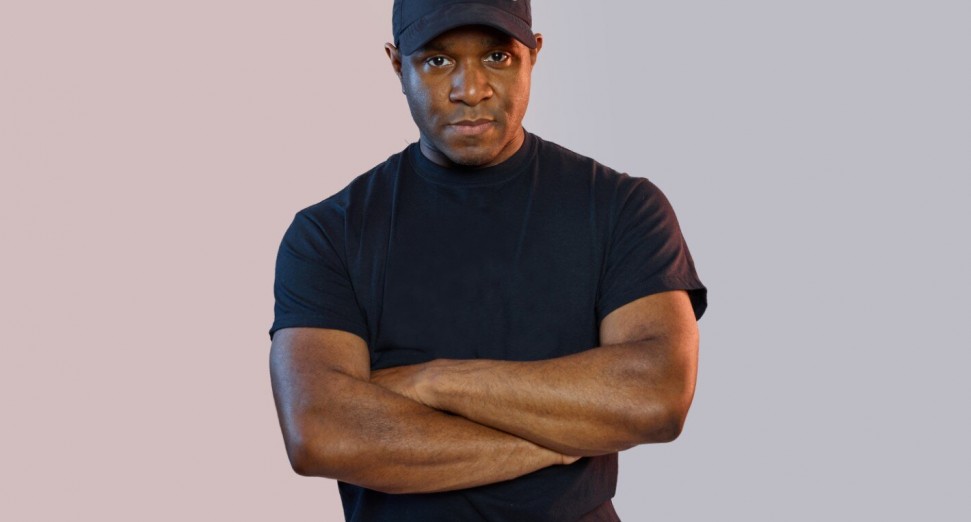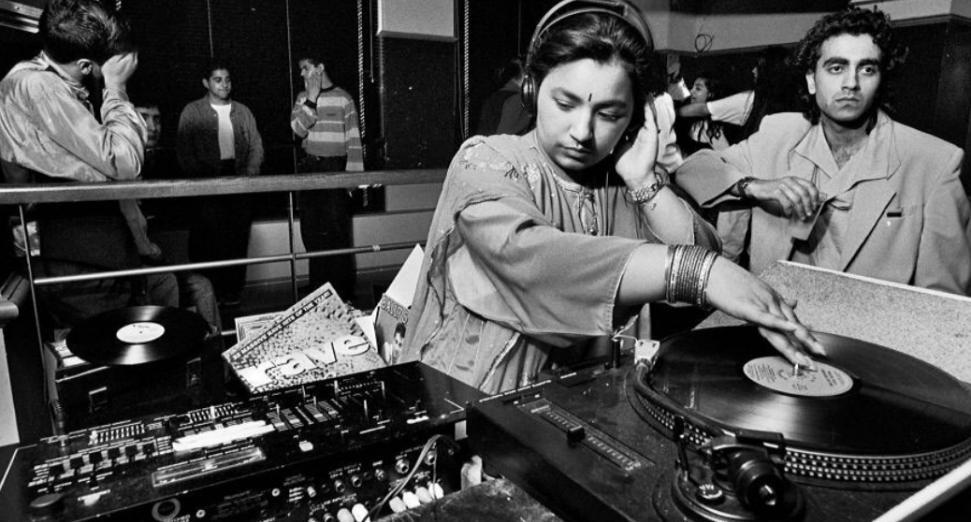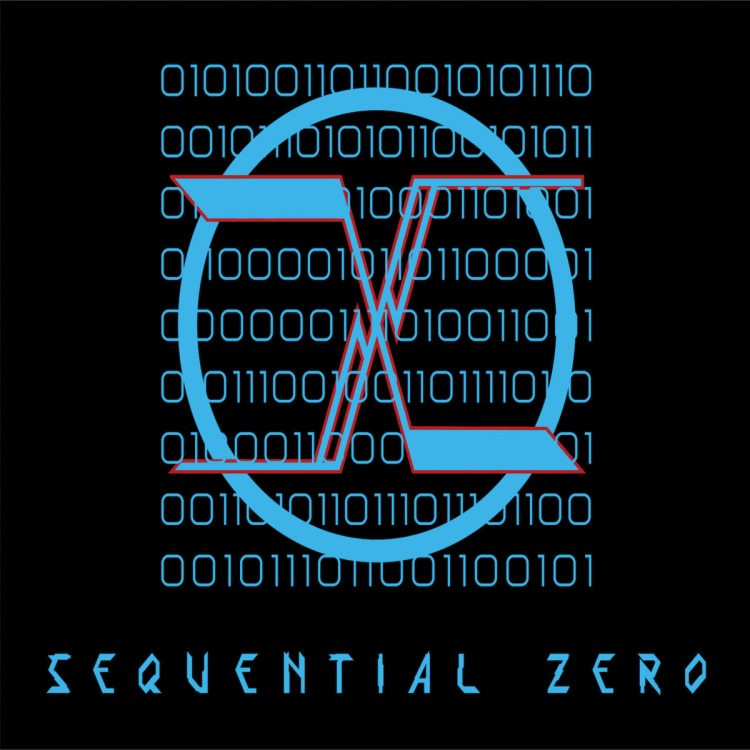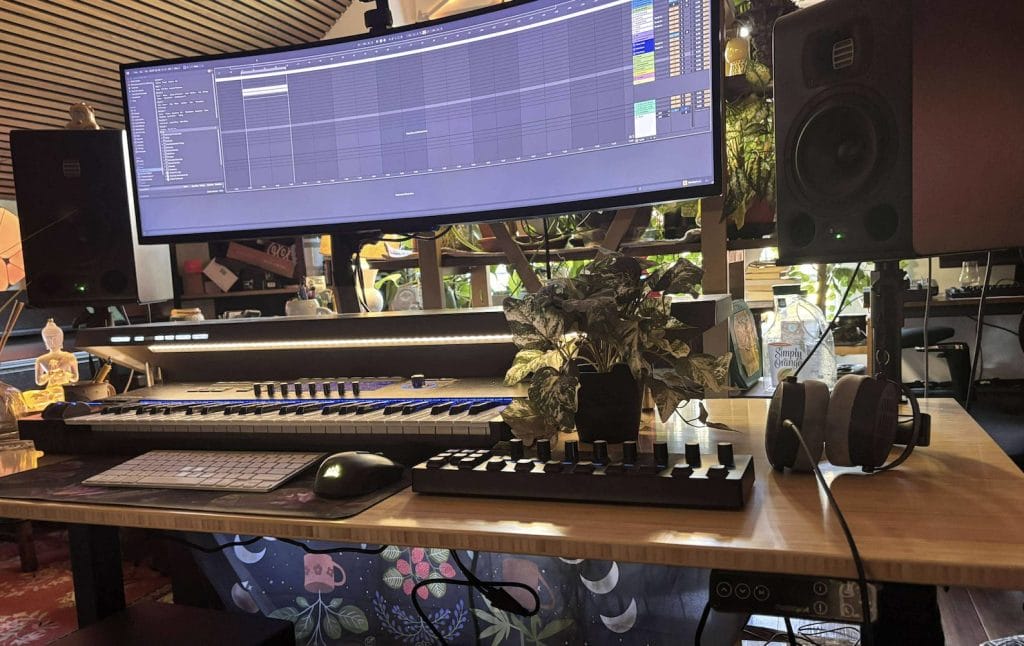
FlexiSpot E7 Plus 4-Leg Standing Desk Review: Built for Real Studio Weight
Table of Contents
I’ve tested plenty of standing desks over the years in my studio, and most of them hit the same wall pretty fast. They look fine, they move up and down, and they can hold a monitor or two before the motors start to sound like they’re working overtime. What pulled me toward the FlexiSpot E7 Plus was its lift capacity. It’s rated for more than 500 pounds, which is a wild number when you think about how much weight a studio setup actually carries. Between monitor stands, a Hexcal Studio riser with lighting, multiple keyboards, and a full-size interface, it adds up fast.
My other premium desk handled most of it well, but my keyboard alone tipped the scale past what it could lift safely. The E7 Plus had another 150 pounds of capacity on top of that, and that was the difference. It meant I could finally have everything I needed on a single workstation that could raise or lower without worrying about anything sliding, shaking, or disconnecting.
First Impressions After Unboxing The FlexiSpot E7 Plus 4-Leg Standing Desk
FlexiSpot products always arrive cleanly packaged, and this one was no different. It’s heavier than most of their two-leg desks, and that extra weight immediately makes sense once you start unpacking it. The frame is solid, the parts are labeled clearly, and the finish looks as modern as anything you’d expect in a professional workspace.
Aesthetics weren’t really my focus this time. I’ve owned studio desks that leaned into design-first thinking, and while they looked great, the function always took a hit somewhere. I wanted something reliable, something that could actually hold everything I throw at it.
The E7 Plus nailed that right away.
That said, it still looks clean. The frame lines are minimal, and the black finish fits into any studio setup without pulling attention away from gear. The overall footprint is larger than my previous desk, which is exactly what I needed. It gave me the space to keep my riser, keyboards, and still have room to breathe.
Setup and Build Experience
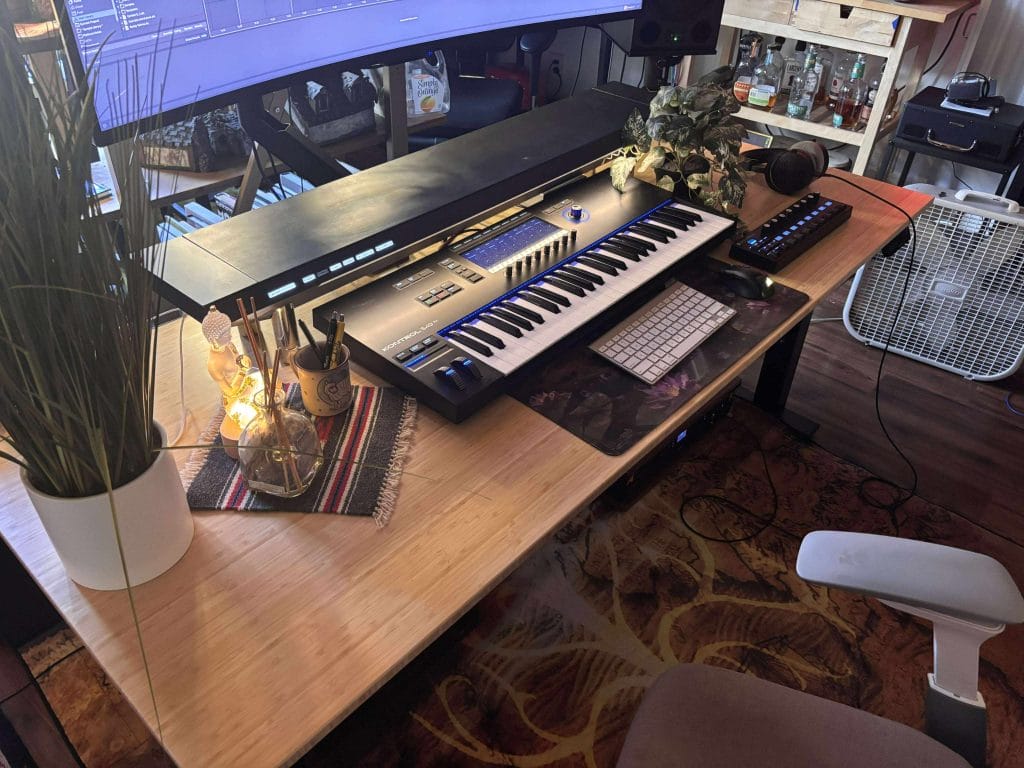
Putting this together took a little longer than usual. Most FlexiSpot desks are up and running in about fifteen minutes. This one took closer to thirty because of the cross-linking supports and the extra structural reinforcement that come with that 500-pound rating. The process itself was straightforward, but the parts are heavier and require a bit more alignment finesse.
Once everything locked into place, it felt secure in a way that gives you confidence before you even power it on. The extra bracing under the desktop is the reason for that lift strength, and it’s also what eliminates flex when you’re leaning into your keyboard or resting your forearms while mixing. I can literally put my body weight on one side and it doesn’t shift or squeak.
Everyday Use and Studio Stability
Over the last two months, I’ve been using the E7 Plus daily, and it hasn’t wavered once. The lift motion is incredibly smooth, almost silent, and steady enough that I can move between sitting and standing with my monitors still powered on. Nothing shakes, nothing rattles, and there’s no moment where you feel like something might tip.
I’ve tried raising it while the full setup was running—two 8-inch nearfields on isolation pads, a 49-key MIDI controller, a MacBook Pro dock, and a stack of rack gear. The motors lifted everything quietly, and the transition didn’t cause even a hint of vibration in the speakers. That’s huge for producers because any movement in the listening field can throw off perspective. Here, it stays locked in.
The four-leg connecting frame design is the real reason for that stability. Most desks rely on dual-column frames, which is fine for lightweight setups, but once you start adding synths, monitor stands, and risers, they start to sway. With four legs, the weight distribution keeps the whole surface rigid, and that makes a difference when you’re hitting keys, adjusting knobs, or even writing with hardware connected.
Quiet Performance for Recording Spaces
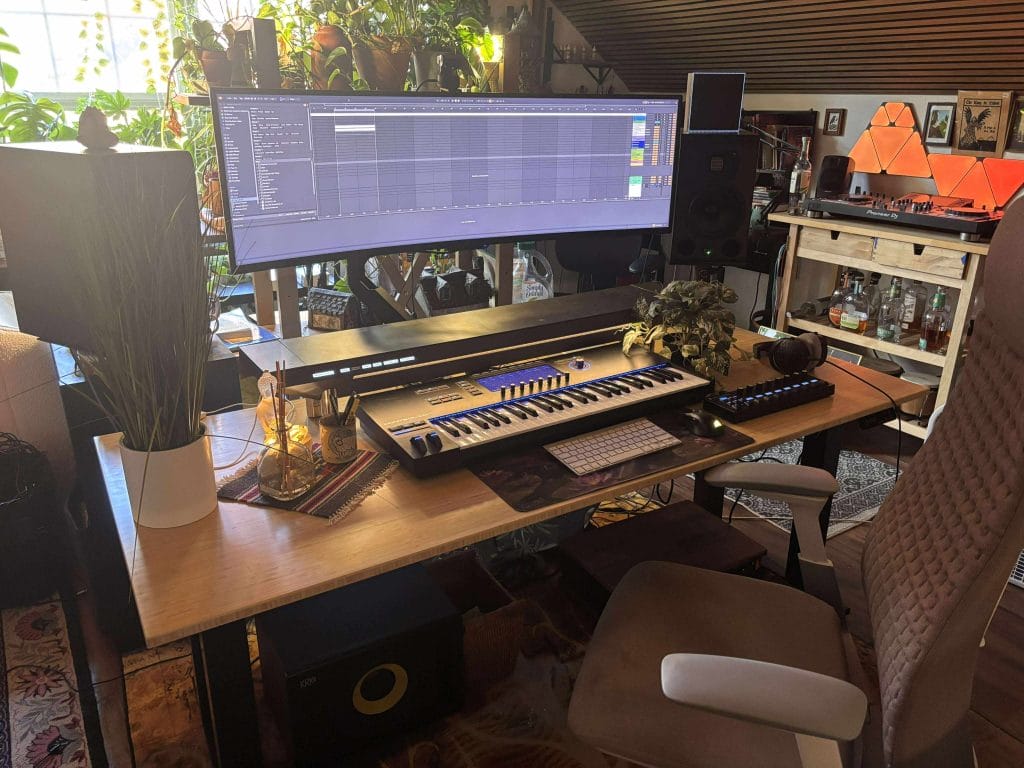
Noise matters in a studio, and this desk stays silent. The motor hum is barely audible even in a treated room. I’ve recorded ambient takes and soft vocals right beside it, and you wouldn’t pick up any mechanical noise even with a sensitive condenser mic active nearby. The transitions are smooth enough that you can adjust height mid-session without breaking focus or interrupting what you’re tracking.
Compared to other desks I’ve used, this one feels engineered with more attention to that noise profile. It’s not just fast—it’s consistent. The stop and start points don’t jerk, which is another thing that keeps everything on the desk stable while moving.
Dialing In Ergonomics That Actually Work
The E7 Plus comes with a small digital keypad where you can program four height presets. I’ve got mine set up for three main positions: one for mixing while seated, one for synth programming, and one for standing editing sessions. It makes it easy to jump between setups throughout the day without thinking about it.
The range goes from 26 to 51.6 inches, which easily covers anyone from short to tall. For me, that means I can move from sitting at an office chair to standing comfortably at ear-level with my monitors without needing to adjust their height. It’s a nice improvement over two-stage legs that top out sooner.
In practical terms, the ergonomics help more than expected. Standing for an hour during editing or idea sessions keeps energy levels up, and that alone has made a difference in how I pace long days. The muscle fatigue I used to feel after a few hours at a fixed height setup is gone.
In-Studio Workflow and Practical Advantages
The main difference since adding this desk has been the workflow flexibility. I can move between sitting sound design sessions and standing arrangement work without breaking concentration. It’s quick, stable, and predictable, which makes it feel like part of the setup instead of a distraction.
I’ve found that standing during creative idea sessions helps maintain focus longer. There’s a subtle mental shift when you move from sitting mix work to standing performance tasks like working on Push 3 or keyboard layers. The E7 Plus makes that transition instant.
It’s also been helpful when I need extra room. Because the desk can lift so much weight, I can temporarily set controllers or extra gear on it while re-arranging without worrying about balance. For collaborative sessions, it’s easy to raise it to a height where multiple people can view the screen and hardware comfortably.
Design, Materials, and Aesthetic Fit
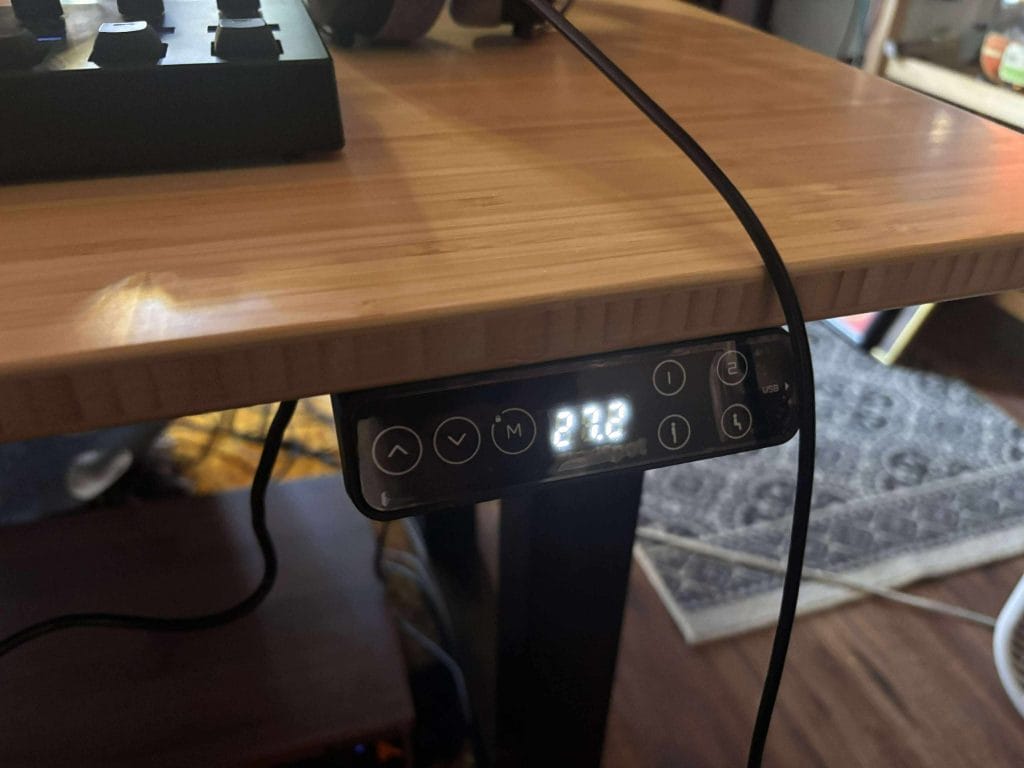
FlexiSpot offers several desktop options—bamboo, chipboard, solid wood, and rubberwood—and each changes the look slightly. Mine has a clean dark finish that blends with studio gear without adding glare from lights or monitors. The edges are smooth, and the feel is sturdy without sounding hollow when tapped.
The style leans modern but neutral. That’s ideal for studio environments because it doesn’t compete visually with gear or acoustic panels. Everything sits balanced. The frame paint is consistent and hasn’t chipped despite two months of heavy use and occasional knocks from moving stands around.
The Real Value for Producers
At $499.99 on sale (regularly $799.99), the E7 Plus hits a sweet spot for serious producers. There are cheaper options that move up and down, but they rarely hold this kind of load or stay this stable. Most “studio desks” in this price range are static, meaning no motorized adjustment at all.
For comparison, my previous desk cost more and couldn’t handle my full keyboard rig. That makes this one an easy recommendation if you need something that grows with your setup. Between the lift range, build quality, and quiet operation, it covers what you’d expect from a premium desk without creeping into the custom-furniture price bracket.
FlexiSpot’s warranty and track record also add confidence. They’ve been consistent about support and replacement parts, which matters if you’re investing in something that literally holds your entire creative workstation.
Who This Desk Makes Sense For
If your setup includes multiple monitors, heavy controllers, or a riser stacked with gear, this desk is ideal. The stability and lift strength keep it from feeling delicate. It’s also a good fit for hybrid home offices where you might switch between work and production tasks throughout the day.
I’d recommend it most to producers who already know the pain of overloaded standing desks or wobbly frames. Once you’ve dealt with that, the E7 Plus feels like a relief. It’s one less thing to worry about while creating, and that mental space alone is worth the price.
It might be overkill for minimal setups, but even then, the smoothness of the lift and quiet motors still justify it if you care about build quality. It feels like it was made for real use, not lightweight aesthetics.
Final Thoughts
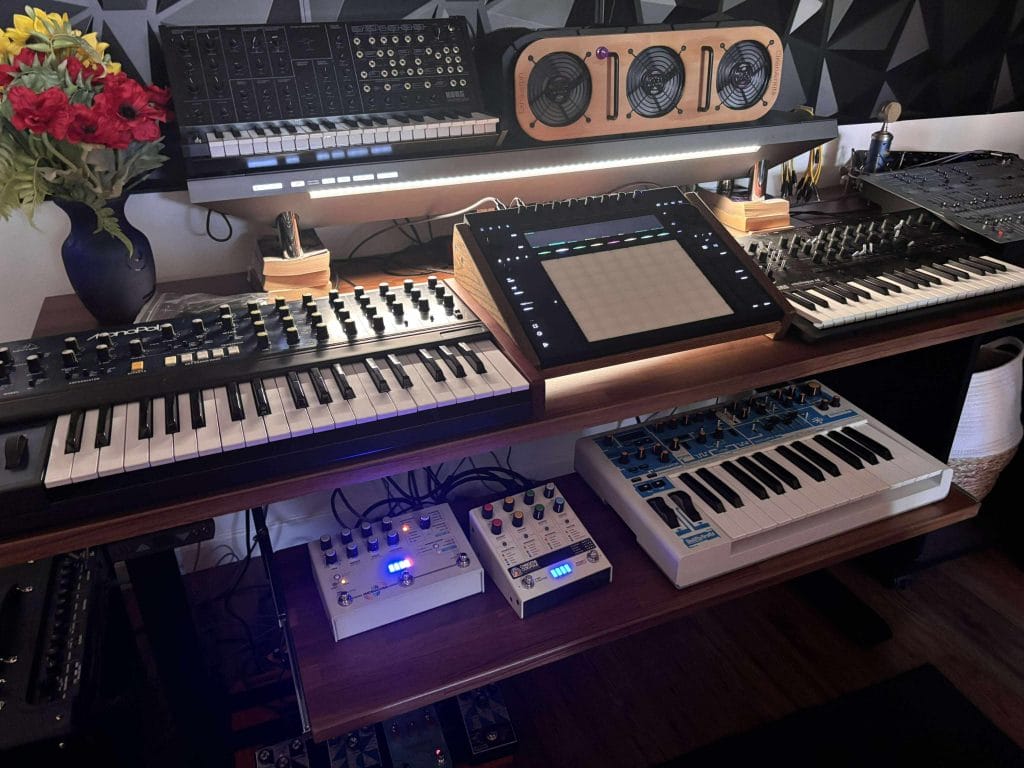
After two months of daily use, I’d call the E7 Plus the most capable standing desk I’ve had in a studio environment. The lift strength changes what’s possible for producers who work with hardware, and the quiet, steady motion means you can keep sessions running while adjusting position without worrying about gear movement.
If I had to point to one area for improvement, it would be refining the cable management accessories to match the desk’s higher-end build. The trays work fine, but a more integrated system would make it perfect.
Everything else—from the motor consistency to the frame rigidity—feels like it belongs in a professional workspace. It’s functional, modern, and actually built for the weight and workflow demands of music production.
For producers looking to make their setup more ergonomic without sacrificing strength, the FlexiSpot E7 Plus 4-Leg Standing Desk is one of the few options that genuinely delivers on both. It’s not flashy. It’s not trying to be furniture. It’s a tool that makes long sessions easier, safer, and smoother—and in any serious studio, that’s exactly what matters.

